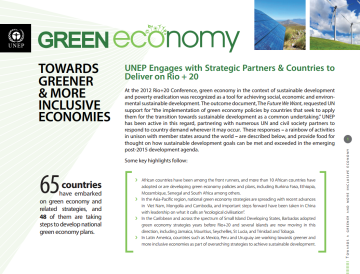
The United Nations Environment Programme (UNEP) has released a new flyer illustrating its engagement with partners and countries in building greener and more inclusive economies.
At the 2012 Rio+20 Conference, green economy was recognized as a tool for achieving social, economic and environmental sustainable development. The outcome document, The Future We Want, requested UN support for “the implementation of green economy policies by countries that seek to apply them for the transition towards sustainable development as a common understanding”. UNEP has been active in this regard, partnership with a number of other UN agencies and organizations, as well as other international organizations and civil society groups to respond to a growing demand for green growth information, tools and support.
The flyer outlines a number of UNEP’s green economy highlights, including:
- Launch of the UN-led Partnership for Action on Green Economy in cooperation with ILO, UNDP, UNIDO and UNITAR, aiming to assist 30 countries by 2020;
- Progress in the UN REDD Programme, including expansion of its work to over 55 countries;
- Linking environmental, social and economic issues in 26 countries through the UNEP-UNDP Poverty-Environment Initiative;
- Launch of the Inquiry into the Design of a Sustainable Financial System, looking to accelerate and scale emerging policy innovations that better align the financial system to sustainable development, environmental and social outcomes;
- Research on emerging trade patterns, including growing South-South Trade and new “green” markets;
- Tools to create the right enable environment and improve our valuation of nature, such as The Economics of Ecosystems and Biodiversity (TEEB), and Valuation and Accounting of Natural Capital for Green Economy (VANTAGE) Programme; and
- Key achievements from UNEP’s partnership in the Green Growth Knowledge Platform (GGKP), including the 30 research papers commissioned to support the GGKP's Annual Conferences and the growing body of green growth knowledge available through its online web platform.
To read the brochure and learn more, click here.
